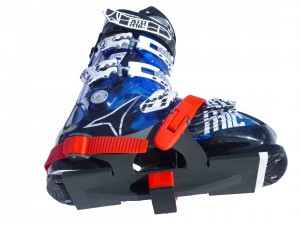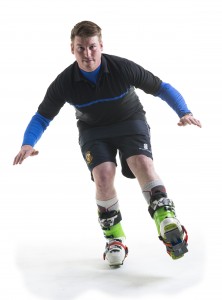Skiing is not only a technical sport, but also one that puts pressures on key areas of the body – especially the knees and the lower back.
Improving natural balance and co-ordination will improve overall technique and will reduce the stress and loading on the body and joints.
However, most skiers are out of balance to some degree. Many skiers balance too far back on their skis, which is an instinctual reaction to travelling down steep snow on skis. To counter this, skiers are commonly told to ‘lean forward’ when they learn and this term is often reinforced by people who misunderstand the command, even instructors.
When you’re skiing, if you attempt to lean too far forwards, it’s normally the upper body that tilts ahead and basic physics states that to remain in balance, if you’re leaning one way, then you need to compensate somewhere else. This normally results in sitting back – or to put it another way, sticking your bum out.
Being out of balance restricts movements, limits control and loads excessive (and unnecessary) strains on the knees and other joints
Top skiers naturally understand centred balance. They develop it over a number of years and it’s programmed into their central nervous system and muscle memory. Such skiers constantly make tiny adjustments to compensate for the changes under their feet. They are dynamically centred on the skis, ready to react and shift their weight according to the terrain and conditions.
But for any athlete, practicing their sport alone is not enough for perfection – top skiers must train strength and fitness, and work on exercises to develop their balance and co-ordination. The SkiA Ski Trainer:
- trains centred balance
- activates sensory and motor neural pathways
- promotes effective movement patterns and develops muscle memory
- stimulates proprioception, particularly in the feet
- develops a strong core
The SkiA Ski Trainer comes as a pair of trainers, designed to be attached to ski boots, and 4 pairs of progressively-smaller balance blocks. Users adjust the trainers so that the blocks are centred under the boot, then balance on the blocks to keep their heels and toes off the ground.
SkiA Ski Trainer attached to ski boot
The largest (green) blocks are relatively straightforward for able-bodied users to balance on. However training on the blocks and performing the recommended exercises can significantly improve centred balance skills for most skiers. The smaller (blue and red) blocks are each more difficult than before and offer a very significant, although achievable, challenge. These will dramatically improve centred balance skills, even for good skiers. The smallest (black) blocks, are only ½ inch wide (1.3 cm), and are equivalent to balancing sideways on a tightrope wearing ski boots. These are a real challenge even for the very top athletes.
Other balance trainers, such as wobble boards, rely primarily on movements of the ankle joints to maintain balance. The SkiA Ski Trainer is designed to be used with ski boots because, with the ankles ‘braced’ by the boots, it’s impossible to balance on the trainers by using just feet and ankle movements. It’s essential to use the whole body to balance. Users have to engage their knees, hips, shoulders, head and arms to stay centred – the whole body is activated (and automatically adopts a dynamic, centred posture).
This is the way that we normally balance – we don’t balance on solid ground by using isolated ankle movements. Therefore the trainer accurately simulates normal (or skiing) balance, but in a much more highly refined and challenging way. It’s a unique challenge – no other balance trainer works this way.
The skills apply to any skier wanting to improve their performance or recover from injury. They also apply to other activities that require centred balance – ice skating, roller skating, surfing, skate boarding, even golf!
But how does this translate to being on skis?
The off-season or summer period is an ideal time to improve the body’s central nervous system programming – little and often creates the best results and ten to fifteen minutes on the ski trainer, a couple of times a week, will produce those changes.
Performing exercises like crouching down, rotating the feet, moving from edge to edge or throwing and catching whilst on the trainer can help. But simply remaining in balance is enough, especially moving onto the blue and red blocks.
When you next ski, your central nervous system will be programmed to be dynamically centred. That in itself will improve performance, stability and safety. Great skiing can be less effort, with less strain and less pain.

